
We’re just back from our local shrine (Daikokuten) where we rattled the bell and had some tasty tonjiru, and Denzuin temple, where we stood in line and rang out Sin #108—the last one of the pantheon of human sins and sorrows.
Tod declared #108 as “being mad at you” but I interpreted in a broader sense of “peevish.” Because, really, I know what “being mad at you” is all about. ;-)
Afterwards we enjoyed sake and notariety as “local foreigners” before heading home to unleash a light stick on the lawn. (Tie a lightstick to a string, activate it, cut a hole in it, swing it around, enjoy the new constellations.)
Now, there seems to be a coffee in my hand and a movie waiting in the other room. Wow!
Happy New Year.
I thought I’d take advantage of a lull during the holiday break to reconfigure the way my mail works. Tod’s been wanting to do this for months and since I’ll be travelling for almost a month starting in the next few weeks, it makes sense to use IMAP—where all the mail is stored on the server, giving me access to the exact same set up from my desktop or laptop or any other computer I care to use.
Except that I use Entourage as my mail client. It’s a Microsoft product that I’ve really been satisfied with—up until now. Entourage and IMPA do not play nicely. It took hours to figure out simple things like moving my folders over to the server. I currently have 1327 messages in my “work” folder. I should have about 800. And to add insult to injury, it’s really, really lsow. The I in IMAP stands for Instant but not if you’re using Entourage.
Argh!!!
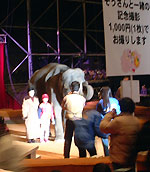 At noon today, seeing the cold, snowy weather outside, I figured we might want to put off our plan to hike around Koto-ku to see the seven lucky gods. I shouted down the hall to Tod “Let’s go to the circus! If we hurry, we can make the 13:00 show…”
At noon today, seeing the cold, snowy weather outside, I figured we might want to put off our plan to hike around Koto-ku to see the seven lucky gods. I shouted down the hall to Tod “Let’s go to the circus! If we hurry, we can make the 13:00 show…”
And so we did. It’s really convenient living so close to Tokyo Dome. We arrived just as they were finishing up taking souvenir pictures with the elephant.
The Bolshoi Circus, is the Japan-travelling branch of the Russian National Circusand will be in town through the middle of February. They have all the classic acts—a trained bear riding a motorcycle, dancers, magic, acrobats, trapeze artists, tightrope walking, clowns, elephants spinning hoops, a woman juggling birds, bicycle acrobatics, and horse stunt riding.
Tod had never been to a circus; I haven’t been since I was a kid. It was really, really fun. And much warmer than walking around Koto-ku. :-)
Have you ever wondered what it’s like to shop in a bustling, old-fashioned Tokyo shopping district?
The Shimaura Discount Chocolate Shop webpage will give you a taste (including a very loud WAV file) of what it’s like to stand in front of their stall in the alleys of Ameyoko near Ueno station.
Frenetic showmen, they work as a team—one man on a platform, surrounded by candy, takes handsful of chocolate bars, boxed candies and seasonal treats and holds them aloft then thrusts them into a plastic bag held up overhead by his assistant on teh ground. 4000 yen’s worth of candy for only 1000 yen! Not a bad deal. It’s chocolate that’s almost reach it’s sell-by date or overruns of special promotions.
They’ve been featured on TV and in print and for good reason. They not only give you candy, they give you a performance, too.
We stumbled across Shimaura a few years ago at the New Year and visited it again this week. You might like to see it for yourself if you’re in town, or virtually if you’re not.
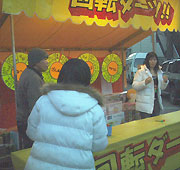 While on a pilgrimage tour to see the 7 Lucky Gods yesterday (read all about it below), we were distracted by a festival in a nearby temple.
While on a pilgrimage tour to see the 7 Lucky Gods yesterday (read all about it below), we were distracted by a festival in a nearby temple.
Among the food stalls serving up everything from mashed potatoes with butter to whole grilled fish on a stick, there were games. I was drawn in by the Kaiten Darts game and had to play. For 500 yen, I got three darts. The target was given a good spin and I threw my darts hoping to hit the thin red line that indicated Big Prize. My first dart hit a yellow prize section; the second dart hit home in the zannen “too bad” section and the last dart bounced off the surface of the spinning board.
Even though I didn’t hit the Big Prize section, I did win a prize that I will have fun playing with.
In the first week of the new year, it’s traditional to make a visit to a temple. The first visit of the year even has a special name, hatsumode. Posters in the train stations and articles in the newspapers give suggestions on which temples to visit. Some of the more popular temples are listed with the number of visitors during the new year so you can decide whether you want to brave the crowds.
Another tradition is to make a pilgrimage (meguri) to seven shrines of the shichifukujin—the Seven Lucky Gods. This year, I decided to try a shichifukujin meguri in Koto-ku. Thanks to the Exploring Old Tokyo page which lists the addresses, I was able to cobble together a map and find my way to all seven. Of course, I dragged Tod along, too.
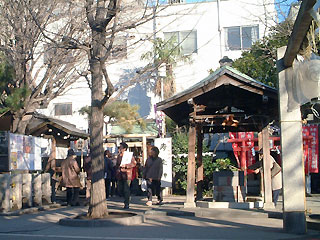 All of the lucky gods offer prosperity, but each one also has a special aspect he or she watches over.
All of the lucky gods offer prosperity, but each one also has a special aspect he or she watches over. 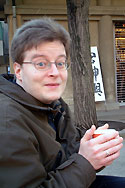 Jurojin carries the secret to longevity in a scroll. He usually wears a scholar’s cap and has a long white beard and a staff.
Jurojin carries the secret to longevity in a scroll. He usually wears a scholar’s cap and has a long white beard and a staff.
At this shrine, there was a long line of people carrying big white envelopes that said "Fukugawa Shichifukujin Meguri" on them. We got in line there and paid our respects to Jurojin by bowing and clapping. I think he most appreciated the coins we tossed into his offerings box.
We looked around for the place that was selling the envelopes, but couldn’t find it. There were plenty of trinkets and things on sale, so we settled for an omikuji, a fortune, and some amazake, sweetened sake with rice floating in it. The amazake wasn’t quite ready, so the vendor gave us each a mikan, mandarin orange, to eat while we waited. We considered having a cup at each shrine—sort of a spiritual pub crawl—but ended up with one here and one at the last shrine.
My omikuji was #47 - chuu kichi, middle luck. You can get a range from great misfortune (dai kyou) to great luck (dai kichi) so middle luck isn’t too bad. Tod got dai kichi - great luck.
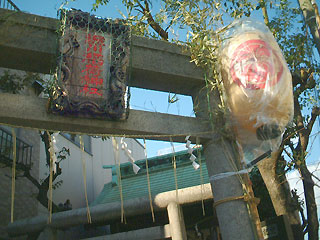 After finishing our amazake, we headed toward the next shrine. Along the way, I realised I really didn’t need my map. The route
After finishing our amazake, we headed toward the next shrine. Along the way, I realised I really didn’t need my map. The route 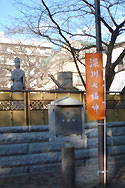 was marked with bright orange banners! The map was helpful anyway, to give an idea of the distance, but it was possible to put it away and just follow the banners.
was marked with bright orange banners! The map was helpful anyway, to give an idea of the distance, but it was possible to put it away and just follow the banners.
They lead us to a small inari jinga on the corner of a small street. This is where Hoteiis enshrined. Officially, Hotei embodies happiness (and prosperity) but I think of him as the god of hospitality. Whether that’s because his name looks like ‘hotel’ or because there is a company in Tokyo called Hotei Wines, I’m not sure.
Hotei is usually shown sitting down, fat and laughing. He is the model for the “laughing Buddha” that is so popular in the US. Hotei is the Japanese name of the eccentric Zen priest, Pu Tai, who wandered around China with a cloth sack over one shoulder. Hotei is sometimes shown with a cloth sack containing riches.
There were no omikuji to be had here, so after offering our respects, we headed back to the street and followed the banners.
 Bishamonten scares the crap out of me. He’s the protector of righteousness. He wears armor, carries weapons, and has a fearsome glare in his eyes. Does righteousness really have to be so scary?
Bishamonten scares the crap out of me. He’s the protector of righteousness. He wears armor, carries weapons, and has a fearsome glare in his eyes. Does righteousness really have to be so scary?
I lost a little of my fear when I fell into line behind the woman in the red coat. It’s covered with Japlish on the back: Dog*O*Shop; Come on a DOS walk with me; DOS is our important friend. It was hard not to giggle.
But then it was our turn to pay our respects. Bishamonten standing inside the shrine was staring down at me, daring me to be unrighteous. I smiled, bowed and drop him a hefty donation before fleeing down the stairs. Wrath of god, indeed.
I bought an omikuji and was delighted to discover that this one came with a special treat. Wrapped up in a slip of gold-flecked paper was a tiny Bishamonten charm. He doesn’t look quite so frightening when he’s scaled down to 2 centimeters, so I’ll put him on my desk and hope he draws in some righteousness for me this year. The omikuji was #30, another chuu kichi. Tod picked up a kichi, but with a kanji we didn’t know. When he looked it up later, it means lowest. So lucky, but not too lucky.
 At midnight on New Year’s Eve, we visited Daikokuten in our own neighborhood. Now were were going for a second visit. I’m not sure if that brings us more attention and luck, but I hope so. Daikokuten looks after food. Back in India, he fights evil but here in Japan, he watches over the kitchen and harvests
At midnight on New Year’s Eve, we visited Daikokuten in our own neighborhood. Now were were going for a second visit. I’m not sure if that brings us more attention and luck, but I hope so. Daikokuten looks after food. Back in India, he fights evil but here in Japan, he watches over the kitchen and harvests
Daikokuten is easy to recognise. He’s one of three short, fat guys in the pantheon of lucky gods and he’s the only one who carries a mallet. It’s a magical wish-granting mallet. In his other hand he usually has a bag of riches and he’s almost always standing on top of rice bales.
In front of us in line was a woman with two terriers. Sort of a compliment of the DOS coat woman from the previous shrine. The dogs were nattily dressed in little sweaters with sports motifs. One was Baseball with bats and balls and doggy bones, and the other was sports of all kinds. I don’t understand the desire to put dogs in sweaters, but it’s very popular here. Fodder for another essay,
perhaps.
Daikokuten’s shrine was full of foodstuffs. And the omikuji system was a little different here. I worry that I did it wrong. At the other places, you went off to the side to purchase your omikuji. There was a bin or a basket for your 100 yen coin, and you pulled a slip out. But here, the omikuji were right along side the offering box. Since we’d each tossed in 100 yen, we took an omikuji, but I wonder if we weren’t supposed to put in an extra 100 yen…
My omikuji was #23 - kichi - luck, which is the same as chuu kichi. On New Year’s Eve, I got a han kichi - half luck. So maybe combined I’ll get 3/4 luck in the kitchen this year. Tod’s two omikuji from Daikokuten were kichi and dai kichi. If you’re coming over for dinner, be sure Tod’s manning the kitchen.
When we left Daikokuten’s shrine, we couldn’t find the route flags to lead us. So I pulled out the map and noted that the closest shrine was about 6 blocks away and around the corner. But where was everyone else? Earlier we’d noticed that the other pilgrims seemed to be following the route in the opposite direction from us. They were coming from the shrines we were going to. Now we were all alone. Peculiar.
As we crossed over one of Koto-ku’s many canal’s we discovered our error—the flags were on the next bridge over! We detoured along a canal-side path to the other bridge and rejoined the proper route. Maybe that was a little silly, since we were about a block from the next shrine when we did that, but the marked path lead through the town’s scenic areas. May as well make our pilgrimage pretty as well as prosperous.
 After our detour, we ended up here to visit Fukurokuju.
After our detour, we ended up here to visit Fukurokuju.
This pretty octagonal shrine, like some of the other shichifukujin shrines, is just a small side area that’s part of a much larger temple or shrine. Buddhist temples have no problem mixing in Shinto shrines as part of their grounds, though I’ve never noticed Shinto shrines with Buddhist fixtures. Three of the lucky gods we visited were at Buddhist temples and four were at Shinto shrines. Fukurokuju is enshrined at a Buddhist temple, as were Daikokuten and scary Bishamonten. I don’t know if these deities are specifically Buddhist or Shinto or whether they are claimed by both or neither.
Religion in Japan is not easily delineated for the layman. I’m sure if you are a priest or a faithful follower it is all clear and obvious. I’m at the level of ignorance where I can confidently say that Buddhist ceremonies are for sad occasions, Shinto for happy ones. And I know that Shinto shrines have torii gates and the pretty bead rosaries are Buddhist. Beyond that, I’m guessing.
Fukurokuju carries a scroll containing the world’s wisdom. He’s also associated with longevity, like Jurojin. They are both depicted as old men with flowing white beards, but Fukurokuju is bald and has a very tall forehead. An egghead deity!
Although his name, Fukurokuju, has kanji that mean “luck amount longevity” I think it’s interesting that the sound of the name, fuku-roku-ju could also mean “lucky 60.” The 12 year, 5 element cycle of the zodiac (2003 is the year of the metal sheep) means that it takes 60 years to go around once. When you reach your 60th birthday, you’ve seen it all—and have achieved wisdom and long life.
Although there were no omikuji to be had here, we later picked up an all-purpose shichifukujin omikuji from a big Buddhist temple that wasn’t part of our meguri. These special omikuji came with gold-plated charms and mine was Fukurokuju. The omikuji was just shou kichi, little luck, so maybe I’ll only be a little bit wise this year. As long as I’m not a little more of a wiseass than usual, I guess I’ll take what I can get.
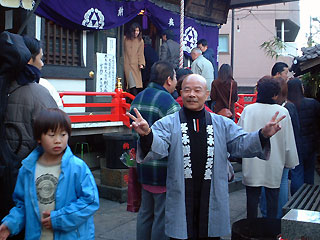 Next we were on our way to the shrine we detoured away from earlier. Benzaiten, also known as Benten, is one of my favorite of the shichifukujin because she is the only goddess among them. I wholeheartedly support women in power. Not only is she the only woman, but she’s also patron of the arts and sciences, literature, and virtue.
Next we were on our way to the shrine we detoured away from earlier. Benzaiten, also known as Benten, is one of my favorite of the shichifukujin because she is the only goddess among them. I wholeheartedly support women in power. Not only is she the only woman, but she’s also patron of the arts and sciences, literature, and virtue.
Inside her shrine she sat leafed in gold and looking lovely playing her biwa (a Japanese lute not the biwa fruit that’s known as kumquat in English). Her interior decorator had gone overboard with flowers, gold lotuses, cushions in rich colors and offerings of fruit, sake and rice. Benten has a cozy home at this shrine. Very inviting. I might have crawled in and played the lute myself except for the long line of other people wishing to pay their respects. And my lack of lute-playing ability…
My omikuji was #47 again (just like Jurojin) — chuu kichi. I also purchased a little gold Benzaiten charm to go with Bishamonten and Fukurokuju. Tod got dai kichi from Benten, so he’ll be prospering in the arts and sciences this year.
I hoped to get a photo of me at this shrine but this nice man offered to take a picture of Tod and me together. However, my camera is not friendly to others and he didn’t actually get the shot. So instead, I took a picture of him. He was funny and did the classic “V for victory” that everyone does in photos here.
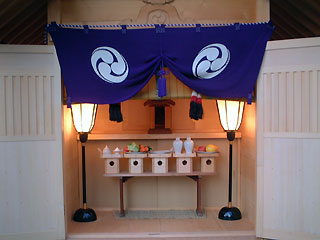 If you’ve been counting your way through this essay, then you know we’re up to the last god on our pilgrimage. He is Ebisu—the same name as the Yamanote line station. Ebisu guards over occupations and is also a deity of rice paddies and fishing. He’s easy to spot because he carries a fish and instead of a staff, he’s got a fishing pole. For a god of careers, he’s got a surprising leisure theme going on. At least in this day and age…
If you’ve been counting your way through this essay, then you know we’re up to the last god on our pilgrimage. He is Ebisu—the same name as the Yamanote line station. Ebisu guards over occupations and is also a deity of rice paddies and fishing. He’s easy to spot because he carries a fish and instead of a staff, he’s got a fishing pole. For a god of careers, he’s got a surprising leisure theme going on. At least in this day and age…
We actually took a wrong turn on the way there, despite the banners and our map, and ended up at the Buddhist temple next door to Ebisu’s shrine. We were distracted by the festival at the temple—rows of brightly colored stalls selling food and games—and completely missed the signs across the street saying “Ebisu this way.”
But we went into a temple that was lovely and very rich and that’s where we got our all-purpose shichifukujin omikuji. Mine came with a Fukurokuju charm, as I mentioned. Tod’s charm was Jurojin and his omikuji was han kichi. But there was no shrine to Ebisu in sight, so I consulted the map and realised my error. We walked back through the festival, I played a game of spinning darts and we crossed the street to our final destination.
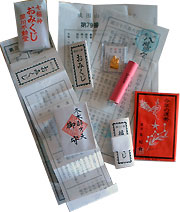 Ebisu’s shrine is newly rebuilt. We were reaching the end of the worshipping day (temples and shrines close at 5 pm) and not so many other people were around so I got a nice clear picture of it. Where Benten’s shrine was cluttered with all sorts of decorations, Ebisu’s was spare and tidy. Extremely calming.
Ebisu’s shrine is newly rebuilt. We were reaching the end of the worshipping day (temples and shrines close at 5 pm) and not so many other people were around so I got a nice clear picture of it. Where Benten’s shrine was cluttered with all sorts of decorations, Ebisu’s was spare and tidy. Extremely calming.
I finally got a dai kichi omikuji so I am looking forward to a very lucky year in my work. Tod’s was only small luck.
In addition to our omikuji, we bought birthday fortunes in bright red packets. These are horoscopes and they’re really long, so I’ve only read a little bit of mine. As these things always do, the profile part says I’m a bossy leader who thinks only of herself. So true. The other part, my horoscope for the year, is divided into four sections (wishes, relationship, money and career) but I can’t read enough of it without the dictionary at hand.
So if you’ve been keeping track, it looks like I’m in for a pretty steady middle luck year but Tod’s going to have a wild ride with big luck in some areas and little luck in others. Neitherof us got any kyou (misfortune) omikuji. Whew.
Today I met a “longtime reader” of this weblog named Jenn—not my sister but another 2-nn Jenn. She’s in town briefly and thought it would be nifty to meet up.
The act of meeting an acquaintance from the virtual world reminded me a little bit of the “old days” back in the early 90s when Chat Thing (the ddial system that got me hooked on computer-mediated communication) and Telerama (the ISP that grew out of Chat Thing) would hold get-togethers for our users. They were sort of like group blind dates. You never knew who you’d be meeting. That erudite writer you enjoyed debating with could be a 14 year old schoolgirl or a 50 year old geek.
Jenn was neither 14 nor 50, though she is a girl and a geek who started programming in 1979. I enjoyed discussing shared interests with her and her friend Denise at the top of the Tokyo Metropolitan Government Building. Afterwards, they went off in search of a moderately powerful hand mixer. If they find one, I’m in line for some of Jenn’s family-recipe brownies. Mmmmmm!
My language is a champon [mixture] of English and Japanese. When I’m speaking English, I throw in maybe 10% Japanese words or use Japanese constructions. If I speak Japanese, there are always English words in the mix.
It must be very confusing to anyone who doesn’t speak both languages. I’ll have to be careful when I leave Japan. Fortunately, everyone around me here does the same thing—mixes up languages at will.
Our vague utterances are always Japanese:
un - Yep
daijoubu? - OK? Are you OK? It that OK?
tadaima - Honey, I’m home.
iyada - No way, I won’t!
ie ie - No, no, no, no
hai - Yes
Sometimes what comes out of my mouth sounds like English, but it really isn’t. Most of the time, I’m not even aware that I’m not really speaking shizen na Eigo [natural English]. Here are some samples:
Must toilet! - I urgently need to use the restroom.
Let’s do sports - Let’s go to the gym.
She really levelled up - She improved dramatically.
I’m losing my English - I am losing my ability to speak and write fluently in English.
I would really like to keep my English, so I’d better level up on my use of shizen na Eigo.
The sewage department has been busy on our street this week—the entire neighborhood smells like benzene. Or maybe it’s some other aromatic hydrocarbon but whatever it is, I’m glad that I’m inside where I can’t smell it.
The workers are out there, unprotected. Nobody I’ve seen is wearing a filter or mask. Won’t long exposure to something so strongly scented cause them harm? Just walking along the street past the construction area, I was really happy to go a little faster than usual.
I’m not even sure what they are doing. Two days ago, they were airing out the manholes with fans and aluminum ductwork; yesterday they had a camera on an optic fiber—sewage endoscopy?
I’ve been busy working on the FCCJ project, so I haven’t had much time to do anything else. However, here’s a batch of updates on previous posts.
- Jenn found the mixer and we met this morning at the Maru Biru for a brownie drop. Mmmmm. They are really good!
- Nobody else has seen the anaguma. After a big rainstorm, I took down the soggy poster.
- My IMAP & Entourage problems continue and seem to be getting worse as I make futile attempts to fix things. If I don’t reply to your mail, it’s probably because some broken process ate it.
- I won 200 yen in the Hatsu Yume (First Dream of the Year) lottery. That’s enough to buy another lottery ticket, but I promised half to the Zous for their travels.
- The “Nipponjin with scissors” entry has been spammed twice more by companies.
- I’ve been going to the gym regularly and amd getting (slowly but perceptibly) more fit. Today I swam laps for the first time in five years.
Shortly before the end of the year, we replaced our coffee maker. The old one was starting to act up—probably due to four maintenance-free years of service—and we decided that it was probably easier and cheaper to replavce it than to try to fix it.
So we bought a new Phillips 12-cup coffee maker. Compared to our old 6-cup model, it’s gigantic. Tod says I don’t have to brew a full pot, but how can I not? Coffee is great stuff. I’ve gone from a modest one and a half mugs of coffee every day to 3 whole mugs. I’m just a little hyper now. O so productive!
We also picked up a thermal carafe. Directly after the coffee’s brewed I pour it into the carafe and it’s still hot (and more importantly not burned) when Tod wakes up several hours later.
So our home coffee life is improved and I’m getting more done than usual.
With a stomach bug going around my friends in the US right now, I thought I’d post a recipe for the Japanese equivalent of chicken soup—okayu (o-kah-you). It’s a very simple rice porridge. It makes a great breakfast even if you’re not sick.
::With raw rice
270 ml/1.25 cups short grained rice
3 l/ 3 quarts water
1/3 t salt
- Bring water to boil, add rice and salt. Cover and simmer for about 45 minutes. The rice should be very soft and the water mostly but not entirely absorbed. Think “watery oatmeal.”
::With cooked rice
190 ml/.75 cup short grained rice (cooked)
1.3 l/5.5 cups water
1/3 t salt
- Bring the water to a boil, add salt and rice, cook for about 15 minutes. The rice should be very soft and the water mostly but not entirely absorbed. Think “watery oatmeal.”
If you want a flavored broth, you can add some miso to the water as it cooks, or use chicken stock. You can add spinach or other vegetables and okayu’s always nice garnished with an umeboshi, scallions, bean sprouts, grated ginger, bits of cooked meat or fish, or strips of fried tofu. For some bland protein, pour in a beaten egg to form egg threads.
Years ago we devised a scale to evaluate a foodstuff compared to its original. We called it the Philly Cheesesteak Continuum because there is only one place to get a true Philly Cheesesteak (a long sandwich of Amoroso’s crusty bread filled with fried beef, optional onions, and topped with cheese)—Philadelphia where this sandwich was invented in 1930.
The farther you get from Philadelphia, the less true to the original. Somewhere North of Camden, NJ, they stop using fresh steak and use Steak-Um frozen beef slices. In Chicago they call it the Italian Beef and though you can see a resemblance to the Philly Cheesesteak, they use seasoned beef, hot and sweet peppers and no cheese. Maybe in California they use whole grain bread, organic beef and soy cheese. On the moon, it’s probably rocks and dust topped with green cheese.
All of this backstory is to explain the weird breakfast I had today. I stopped into a Vie de France cafe for a quick bite before running errands this morning. Vie de France has all kinds of lovely pastries pretending to be French, but we all know there are no bean jam doughnuts in France. They also carry savory baked goods like Vienna sausage rolls and curry doughnuts. This alone puts them pretty far along the continuum from French cafes.
But today’s piece de weirdness was the Fish Dog I found among the savory baked goods. The Fish Dog is a split bun filled with fingers of crispy, breaded, fried fish topped with creamed mushrooms and cheese, then broiled to brown the cheese. It was quite tasty, but if I were to notch it down a level in quality, I’d end up with a white-trash American delight: a hot dog bun with fish sticks, cream of mushroom soup and pizza cheese.
If the Fish Dog was meant to be kin to a hot dog, it is far, far down the continuum. Then again, Fish Dog might be a Vie de France original—at the start of the continuum— and all others are simply imitations.
Yesterday, I spent hours auditioning royalty-free music for the video. Choosing the right music is critical to the tone and feel of the project and it’s one of the hardest things about the artistic process for me.
You may not ever have listened to royalty-free music on purpose, but I’ll bet you’ve heard it. The background music of training videos, corporate ads, commercials, and TV news programs is the sort of music that can be found in royalty-free collections. Lots of this music is really terrible!
So why use royalty-free? Because getting the rights to songs people would recognise is expensive, time-consuming and complicated. I’m cheap, impatient and lazy. For the cost of a meal, I can download a royalty-free track; for a couple hundred dollars I can buy an entire collection of royalty-free music. Once I’ve bought it, I can use it as often as I want without paying another yen.
Although inexpensive sometimes means bad, there are some talented musicians working in the field:
I’m not 100% happy with the music I’ve selected for Hello Tokyo, but I think it’s 90% right, so I’m going with it.
Tokyo has more restaurants per capita than most major cities. Home kitchens are small and there are lots of overworked single people who just want an easy, quick bite to eat after a long day of work. With so many restaurants, statistically speaking you know there are going to be some exceptionally good ones. And some really bad ones, too.
Tonight we visited a really good one. A little Indian restaurant tucked around the corner from the main drag in Yotsuya. (Little India Yotsuya 1-1-6 B1F, for those of you in town). This little gem has three Indian chefs running the show and there were dishes on the menu we’d never seen anywhere, including a potato-spinach croquette and a paneer curry in onion gravy. Yum!
Unlike some of our lucky stumbles (out of the rain, usually) Little India was not a chance find. Their business card was tacked up on the restroom wall at Ampresso. Tod took note. And I’m awfully glad he did. Dinner was delicious.
The January issue of the FCCJ’s newspaper, No. 1 Shimbun, should be subtitled the “Kristen McQuillin Special Issue” or “All the Kristen That’s Fit to Print.” I wrote or co-wrote three of the 18 articles, my picture appears twice and there’s a profile of me as their new webmaster that paints me in a very favorable light (thanks to Jon for the magic paintbrush!).
All in all, my name is mentioned ten times. If anyone at the club doesn’t at least recognise my existence, it’s because they didn’t pick up a copy of the newspaper.
I’m sorry that I can’t show you quite yet, but on January 28th all will be unveiled. Stay tuned!
Next Tuesday, I’ll be spending the day with my niece’s 5th grade class. I’ll be teaching them about all sorts of Japanese things. Today I drew up really brief lesson plans for each of the classes so her teachers know what to expect.
In Science we’ll talk about how digital cameras work (after discussing Japan’s famous technology companies); Math is an abacus lesson; Reading is Japanese folktales; Spelling is writing names in katakana. In Social Studies, we’ll try rice crackers and green tea and in English we’ll decode some Japanese English words (Do you think anyone will get pasocon? I threw it in for a challenge!)
It will be a fun, but very tiring day.
Excuse me, I have to go prepare some katakana handouts
DigitalEve Japan is approaching its second anniversary. The core of women who started the group have expended a lot of energy—sometimes productively planning and executing events, sometimes envisioning a better world and trying to make it happen, sometimes agonising over one particluarly challenging member.
Like most volunteer organizations, DE-J suffers from member apathy and leader burnout. And those of use who’ve been on board the whole time are getting pretty tired. But at this evening’s SC meeting, we renewed our energy with some new ideas that, if we get them off the ground, should make progamming and accomplishing our mission much easier.
We’ve always wanted our members to take on responsibility for their own learning and increase their participation of their own accord, instead of having the SC manage every aspect of every program. Now we are going to advocate small, special interest groups. We’ve put forward the idea a few times before with limited success but this time we’re hoping it will take off because we are cutting back on our SC-initiated programming.
So burnout might bring benefits to the group by encouraging members to participate more and form a stronger community. Which is the best part of DigitalEve Japan, except for that one annoying member.
Until today, I’d never seen a naked Japanese baby.
But we were invited to dinner at a friends’ house this evening and got an entertaining bonus—admission to the daily bath. Our friends’ son is such a cutie and so patient as his mama washed his hair and baba held his legs. Junior thinks he’s swimming in his tub and kicks like crazy.
And I learned something interesting from this bathing 6-month old. Many Japanese babies are born with a blue birthmark in the “sacral region.” It looks like an ink blot or a dark bruise. But it’s not a bruise and it fades with a few years. His is just at the end of the tailbone.
Apparently this Mongolian Blue Spot is a genetic marker traced back to the Mongols and it appears not only in most Asian races, but also Turks, Greeks, Africans, Eskimos and Native Americans.
I’ve uncovered two folk explanations for the spots. The Mongols say they are the mark left by the spirit who slaps the baby to life. Chinese believe that if you are reluctant to be reincarnated, the King of Hell prods and kicks you until you agree to go. The more spots, the more reluctant you were to be reborn.
It still doesn’t quite work—every time I quit Entourage, or if the IMAP server is jostled, I lose all of my filters. So every day or so, I have to reset all of my filtering rules. I’ve cut them down to a bare minimum so it only take a few minutes, but I really shoudln’thave to reset the filters everytime I launch the program.
But other than that, it’s doing pretty well.
Tod spent hours today sorting out the firewall rules and Exim details so that I can send and receive mail using Entourage instead of webmail while I’m away. What a sweetheart.
Mad cow # 6 was announced today. This one came from Wakamatsu via Hokkaido.
To put this in persepctive, Britain’s mad cow epidemic was 155,000 cases over a ten year span—as many as 1,000 new diagnoses per week at its peak. So Japan’s six cases in a year isn’t as bad, but it’s still not good.
I’ve been eating beef. Have I also been playing prion roulette?
Made a quick trip to the Price Chopper to get some salad makings for dinner. Boy, are American grocery stores intense.
In this giant warehouse of a shop there are 21 different kinds of Dole pre-packaged lettuce. Pickles have 7 six foot shelves. Mustard and ketchup each have 4 feet of shelf space times 7 shelves!
And ther were so many kinds of salad dressings—at least 15 feet plus an endcap display—that I gave up trying to choose one. I got olive oil and basalmic vineagr instead.
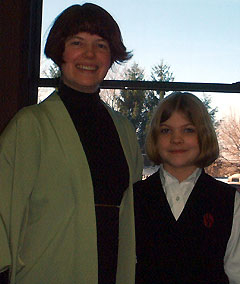 Today I spent the day at St. Nick & Mary Elementary. I’m exhausted but the kids were so much fun.
Today I spent the day at St. Nick & Mary Elementary. I’m exhausted but the kids were so much fun.
They were a bit wigged out by the nori and I was surprised that they didn’t really like the green tea (sweetened, even). We learn some soroban basics; took pictures with the digital camera; tried writing our names with katakana. I told them stories and we wrote kanji. It was a day full of Japan and Japanese things. I hope they had a good time; I definitely did.
I had lunch in the cafeteria—hamburger, fries, overcooked beans and canned apricots. School lunches have not changed in the last 20 years.
Will today’s activities help me get over jet-lag? Probaly not. I’m feeling that dead tired drag right now. My brin is melting and my body is cold to the core. Must go have some more of the leftover green tea, I think.
Riding in a car makes me [select some: nervous, tense, panicky, morbid, frantic]. Today’s 20 minute trip from Jenn’s house to a cafe in the next town over had me doing deep breathing to stay calm. Nothing to do with my sister’s perfectly safe driving style, this is all me.
The signs along the highway didn’t really do much to relax me:
AGGRESSIVE DRIVERS
HIGH CRASH AREA
SLOW DOWN
SAVE A LIFE
I miss Tokyo. Where are the trains here? Funny thing is, I know where they are—in a Scranton museum called Steamtown. :-(
Jenn is doing a poet-in-residence program at Heights Terrace Elementary in the Hazleton Area school district where I when to school. Tomorrow she has two long sessions with 4th graders and I was going to go in and help her do renga, Japanese chained poetry, with them.
Only I don’t have an Act 34 clearance so I’m not allowed. Act 34’s basically a certificate from the police saying you don’t have a criminal record. I had one a long time ago when I was doing my student teaching and when I was certififed to teach here in PA, but it’s long expired.
I can understand Act 34 clearances for classroom teachers who have regular contact with the kids, but for guests? I suppose the public schools don’t let uncleared parents come in to volunteer. And they must not invite businessmen to speak or have famous people give presentations. That’s madness.
Yet another reason to dislike the US. My list is growing…
OK, for all you who say I shouldn’t hate the US for its inflexible rules, irresponsible people, fatness, lack of privacy, horrifying overuse of cars, and the 45 other things that are on my “Why America SUCKS” list—there is one thing that I like about the US. It has good bookstores.
I was in an enormous Barnes & Noble today that kept me entertained for nearly three hours. I bought 2 novels, two technical books, and a picture book for under $100. And I had lunch there, too.
Unfortunately, what should have been a bit of relaxation with my sandwich and latte was marred by the very loud (#6), mindless chatter and bickering of the cafe employees.
(And a side note: why is it so hard to find gloves in late January? I could have had flip flops and short sleeved t-shirts at three stores, but only one had any gloves—in two colors and two styles.)
Today we went ice skating.
I haven’t been on skates in ten years but after two slow and clumsy laps around the rink, I was doing pretty well. I skated for about an hour without falling down once. Even after the zamboni machine smoothed off the ice.
A blister sidelined me, but I was consoled with hot chocolate. Now that’s a good winter afternoon!

Friday, 3 pm. Nice kitchen.

Sunday, 6 pm. Wow kitchen!
It’s amazing what some paint and energy will do for a room.
The Foreign Correspondents’ Club of Japan website launched about an hour ago.
Still struggling with one issue—e-mailing all the members to let them know their user IDs is not working as advertised—but I hope to have it resolved soon.
In the meantime, enjoy the site and feel free to give your opinion in the comments here.
Last night, Jenn, Helen & I went to a Japanese restaurant that opened just a few weeks ago. It is a teppanyaki restaurant—called hibachi in this neck of the woods—the sort of place I’ve never been to in Japan. I’m sure they exist, but maybe only for an expense account budget.
I felt strangely out of place and homesick. The restaurant was pretending to be Japanese and it was close, but it wasn’t quite right. The decor was inspired by Japan, but the wainscotting and dentil molding didn’t quite work. There was entirely too much space between tables. The food was delicious, but it wasn’t Japanese, though it had a Japanese style. The quantity alone pegged it as not Japanese—my meal was piled high on platter the size of an LP.
On top of that, I was the only person in the restaurant who could speak Japanese. I found this out because our waiter asked me if I’d lived in Japan (maybe he overheard me telling Helen about Japanese things or wondered why I asked him what brand the sake was) and confided that all the staff were Chinese.
One week down, three weeks ‘til I can go home. Don’t get me wrong, I’m enjoying my trip. It’s great to see everyone and I’m amused by America. But I miss home. Tod, darling, could you please bring me some mochi, senbei, and Lemon Water in your suitcase? Onegai shimasu
My grandmother is dying. At 88, she lived independently until a fall in early November sent her in and out of hospital and nursing home in a downward spiral. She’s getting near the end now and each day bring some new twist in the spiral. Jenn said I wouldn’t recognise her when I went to visit.
Of course, I did know her. She still has her own light in her eyes, though it’s dimmer than I recall. I’d like to think she recognised me, too. Maybe. Perhaps not. She wasn’t talking, just moaning in a frustrated, painful way until she fell asleep.
Her hands are restrained because she plucks at her tubes and wires. Her left hand is swollen and purple; the skin of her right palm is red and cracked. But her nail are, as always, beautifully done.
When I was about 11, she gave me a manicure kit covered in magenta suede that snapped closed with a gold fixture like a change purse. Inside were slots filled with files, tweezers and inscrutable implements with plastic mother-of-pearl handles. “A lady always keeps her nails neat,” she told me, looking pointedly at my ragged chewed fingers. I figured out how to use all of those tools, but looking down at my hands now (a tiny hint of green paint under my right index finger, dry cuticles glaring white in every corner, cracked and ugly edges from nibbling) I wish I had inherited her strong, gorgeous nails.
They say the the nails continue to grow after death. But it’s not true, just an old wive’s tale.
Part of the daily routine at my parents’ is watching Jeopardy on TV, so I’ve been hanging out questioning the answers along with them. I’m really bad at it. “The author of this 17th century novel wrote about his scurvy.” I’m amazed the the contestants know the answers.
I’m more astonished by the ads that air during Jeopardy. 80% of them are for prescription medications. “Ask your doctor if Premoxolipicidil is right for you.” Dorothy Hammill plays crack the whip with a passel of kids while talking about arthritic joint pain; old men walk dogs while voice overs explain that their life is improved by a specific brand of anti-depressant; smiling women show off their soft-focus children and good blood pressure thanks to some drug or another.
These are not over-the-counter medications. They are probably not used by more than a very small percentage of the population. Take high blood pressure as an example. The CDC says that 25% of Americans experience it during their lives, but most can control it through exercise and diet. Why advertise something that the general population doesn’t need? It’s not like advertising a new toy or a food that’s unnecessary but might become a fad. This medication has to be prescribed. Do these ads have a good return for the drug manufacturers?
“Oh, my diagnosis is arthritic joint pain? Can I take the same stuff as Dorothy Hammill, please? I love those ads!”
